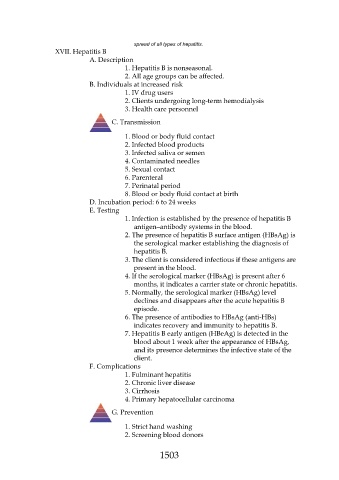Page 1503 - Saunders Comprehensive Review For NCLEX-RN
P. 1503
spread of all types of hepatitis.
XVII. Hepatitis B
A. Description
1. Hepatitis B is nonseasonal.
2. All age groups can be affected.
B. Individuals at increased risk
1. IV drug users
2. Clients undergoing long-term hemodialysis
3. Health care personnel
C. Transmission
1. Blood or body fluid contact
2. Infected blood products
3. Infected saliva or semen
4. Contaminated needles
5. Sexual contact
6. Parenteral
7. Perinatal period
8. Blood or body fluid contact at birth
D. Incubation period: 6 to 24 weeks
E. Testing
1. Infection is established by the presence of hepatitis B
antigen–antibody systems in the blood.
2. The presence of hepatitis B surface antigen (HBsAg) is
the serological marker establishing the diagnosis of
hepatitis B.
3. The client is considered infectious if these antigens are
present in the blood.
4. If the serological marker (HBsAg) is present after 6
months, it indicates a carrier state or chronic hepatitis.
5. Normally, the serological marker (HBsAg) level
declines and disappears after the acute hepatitis B
episode.
6. The presence of antibodies to HBsAg (anti-HBs)
indicates recovery and immunity to hepatitis B.
7. Hepatitis B early antigen (HBeAg) is detected in the
blood about 1 week after the appearance of HBsAg,
and its presence determines the infective state of the
client.
F. Complications
1. Fulminant hepatitis
2. Chronic liver disease
3. Cirrhosis
4. Primary hepatocellular carcinoma
G. Prevention
1. Strict hand washing
2. Screening blood donors
1503

